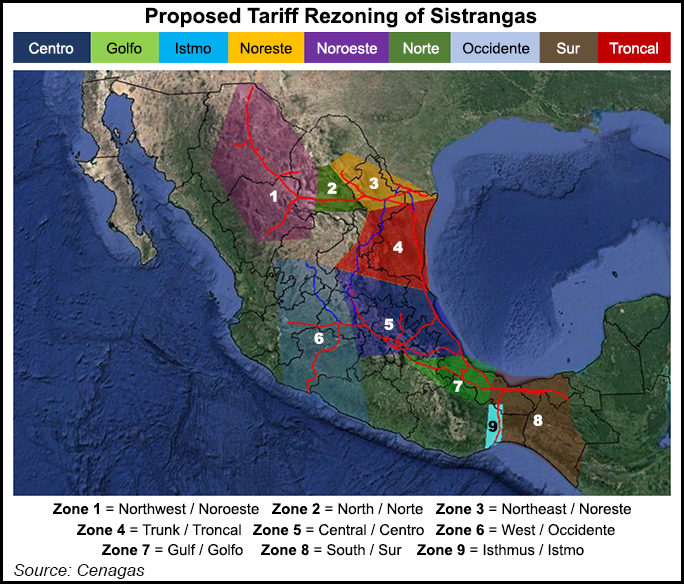Regulatory | NGI All News Access | NGI The Weekly Gas Market Report
Cenagas to Overhaul Transport Tariff Regime for Mexico’s Sistrangas
The operator of Sistrangas, Mexico’s largest natural gas pipeline network, has released a proposal for a revamped transport tariff regime that would take effect later this year.

The Centro Nacional de Control del Gas Natural (Cenagas) last week published a proposal that, in addition to updating the Sistrangas transport rates, would redesign the tariff zones used to charge users that move gas through the system.
“We believe these rates will allow us to provide continuity for the system and, above all, to maintain a tariff base that ensures stability in the fees charges to our users,” Cenagas’ Eduardo Prud’homme, head of the technical and planning unit, said during a conference call with reporters.
“These still aren’t official,” he added. “At the end of March we’re going to submit the tariffs” for approval to the Mexican energy regulator, the Comision Reguladora de Energia (CRE).
Sistrangas is currently organized into six tariff zones, each with its own postage stamp rate. The transport tariffs, updated every six months in a review process overseen by the CRE, accrue as gas flows from zone to zone.
The Cenagas proposal would maintain the postage stamp system, but it would redraw the map, dividing the pipeline system into nine zones, each with its own transport adder. The reconfigured zones are intended to reflect current commercial and operating conditions on the Sistrangas, whose existing tariff scheme predates the creation of Cenagas and the incorporation of the Los Ramones Norte II pipeline into the system.
The Sistrangas is comprised of the national pipeline system, directly owned by Cenagas, and six private pipelines. The 10,212-kilometer (6,345-mile) integrated network spans 21 of Mexico’s 32 states, including the federal district, and has an operating capacity of 6.4 Bcf/d.
Most of the new tariff zones in the Cenagas proposal would be located in northeast and central Mexico. The operator wants to boost its competitiveness along three main shipping routes from the:
â— West Texas border, where Mexico imports gas from the Waha region, to the city of Guadalajara in central Mexico;
â— South Texas border down the coast to the Mexican port of Tuxpan in Veracruz state, paralleling the offshore route of the privately owned 2.6 Bcf/d Sur de Texas-Tuxpan marine pipeline, due in-service at the end of this year; and
â— Tuxpan to Guadalajara.
The current Sistrangas transport rates are valid until the end of June. Once approved, the new rates would take effect on July 1 and remain in place until the end of the year.
The implementation of the new tariff regime would coincide with the start date for new capacity reservations on the Sistrangas, which Cenagas is in the process of renewing.
Shippers reserved 97% of the capacity on the system during an assignation process in the first half of 2017. That process included an open season in April in which 24 companies took 2.35 Bcf/d.
All in all, private shippers hold rights to around 16% of the Sistrangas capacity. The remainder is distributed among national oil company Petroleos Mexicanos (Pemex), as well as the state electricity utility Comision Federal de Electricidad (CFE) and its independent power producers.
All of the 2017 capacity contracts have one-year terms that expire at end of June.
Cenagas officials had originally indicated they would hold a second open season in the first half of 2018 to replace the expired contracts by July 1. However, that plan has now mutated into a renewal process for existing contracts, while the second open season has been postponed until a later date.
Under the new process, Sistrangas shippers may renew, reduce or completely relinquish capacity, but they may not take more than the maximums set by their contracts as “that would take us into an open season,” Prud’homme said.
“What we’re trying to do is utilize what’s allowed under the existing regulations to provide more certainty for our users and for ourselves as a system,” he said. “Holding an open season would have meant going back to square one.”
The renewal process would allow contract-holders to switch injection points on the Sistrangas “as long as it’s technically feasible,” according to Prod’homme. In the first open season, shippers were heavily concentrated at the Ramones injection point, which interconnects with the NET Mexico pipeline in South Texas; at the Pesqueria interconnection with Kinder Morgan’s Mier-Monterrey import pipeline in Nuevo Leon, also on the South Texas border; and at the Cactus gas processing center in southern Mexico.
Cenagas is also allowing shippers to renew capacity for longer terms. The new contracts would have a one year minimum, but no maximum.
The new contracts “will probably be for one to three years, but we have heard from users that want more time, so we don’t want to limit anyone,” said Prud’homme. The operator is also working to incorporate into the new contract models suggestion from its shippers related to nominations, metering and system balancing, he added.
Cenagas would receive capacity renewal requests from shippers between Monday (Feb. 26) and March 9, according to a timeline released earlier this year. The operator then would evaluate those requests from mid-March to mid-April, notify users of the results by the end of April, and sign the contracts in May.
Once the renewal process concludes, a second open season could come as early as 2018.
“We hope that maybe some users will want to release capacity based on their current utilization levels,” Prud’homme said. “So once that capacity is released, we can make it available through an open season or in our electronic bulletin board, depending on the volumes and the routes.”
© 2024 Natural Gas Intelligence. All rights reserved.
ISSN © 2577-9877 | ISSN © 2577-9966 | ISSN © 1532-1266 |
